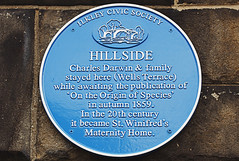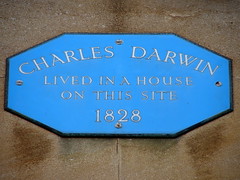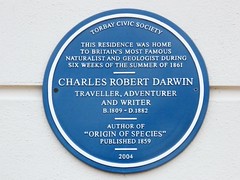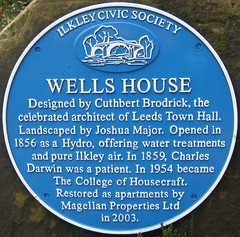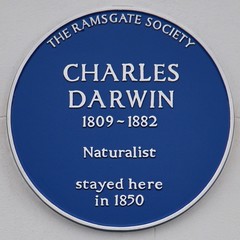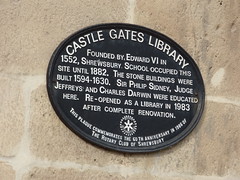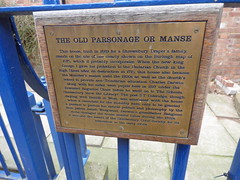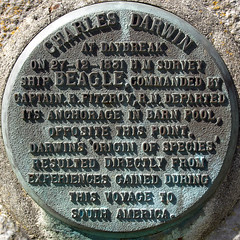Charles Darwin
Commemorated on 18 plaques
Charles Darwin 1809-1882 naturalist lived in a house on this site 1838-1842
Biological Sciences Building, University College, (site of 110) Gower Street, Camden, WC1, London, United Kingdom where they lived
In 1851 Charles Darwin stayed here with his daughter Anne Elizabeth who was being treated by pioneer of the Malvern Water Cure Dr James Manby Gully.
Montreal House, Worcester Road, Malvern, United Kingdom where they stayed
Hillside. Charles Darwin & family stayed here (Wells Terrace) while awaiting the publication of 'On the Origin of Species' in autumn 1859. In the 20th century it became St Winifred's Maternity Home.
Crossbeck Road, Ilkley, United Kingdom where they stayed
Charles Darwin 1809-1882 Kept in lodgings on this site in 1828 while an undergraduate of Christs College
28 Petty Cury, Cambridge, United Kingdom where they lodged
Charles Darwin lived in a house on this site 1828
Boots - Sidney Street / 28 Petty Cury, Cambridge, United Kingdom where they lived
This residence was home to Britain's most famous naturalist and geologist during six weeks of the summer of 1861 Charles Robert Darwin traveller, adventurer and writer b.1809-d.1882 author of Origin Of Species published 1859
2 Meadfoot House, Hesketh Crescent, Torquay, United Kingdom where they lived
Wells House Designed by Cuthbert Brodrick, the celebrate architect of Leeds Town Hall. Landscaped by Joshua Major. Opened in 1856 as a Hydro, offering water treatments and pure Ilkley air. In 1859, Charles Darwin was a patient. In 1954 became The College of Housecraft. Restored as apartments by Magellan Properties Ltd in 2003.
Wells House, Ilkley, United Kingdom where they was a patient (1859)
On this site Charles Darwin (1809-1882) author of The Origin of Species lodged at 11 Lothian Street while studying medicine at the University of Edinburgh 1825-1827
Rear wall of National Museum of Scotland, South College Street, Edinburgh, United Kingdom where they lodged
Charles Darwin 1809-1882 naturalist stayed here in 1850
8 Paragon, Ramsgate, United Kingdom where they stayed (1850)
Charles Darwin 1809-1882 arrived at Falmouth aboard 'The Beagle' on 2nd October 1836 and departed on the Royal Mail coach from this site
Fish Strand Hill, Falmouth, United Kingdom where they landed near (1836)
To the memory of Charles Robert Darwin author of "The Origin Of The Species" born in Shrewsbury, February 12th 1809. In early life a member and constant worshipper in this church. Died April 19th 1882
Shrewsbury Unitarian Church, Shrewsbury, United Kingdom where they worshipped
Charles Darwin 1809-1882. Charles Darwin was born in this house on 12th February 1809
The Mount House, Shrewsbury, United Kingdom where they was born (1809)
Charles Darwin 1809-1882. Disembarco en esta caleta de wulaia, centro del territorio yamana el 23 de enero de 1833. Su estadia en Chile entre 1832 y 1835, durante su viaje a bordo de la "Beagle", contribuyo a la elaboracion de sus idea cientificas. Homenaje en el bicentenario de su natalicio.
English translation: Charles Darwin 1809-1882. Disembarked from this cove Wulaia, center of Yamana territory Jan. 23, 1833. His stay in Chile between 1832 and 1835, during his trip aboard the "Beagle", contributed to the development of their scientific idea.
entrance to the old meteorology station, Bahia Wulaia, Chile where they landed near
Castle Gates Library Founded by Edward VI in 1552, Shrewsbury School occupied this site until 1882. The stone buildings were built 1594-1630. Sir Philip Sidney, Judge Jeffreys and Charles Darwin were educated here. Re-opened as a library in 1983 after complete renovation. This plaque commemorates the 60th anniversary in 1986 of The Rotary Club of Shrewsbury
Shrewsbury Library - School Gardens, Shrewsbury, United Kingdom where they educated
The Old Parsonage or Manse This house, built 1689 for a Shrewsbury Draper's family stands on the site of one clearly shown on the Burleigh map of 1575, which it probably incorporates. When the new King George I gave his protection to the Unitarian Church in the High Street after its destruction in 1715, this house also became the Minister's manse until the 1920s as well as the church's school to provide non-Trinitarian education. Charles Darwin along with his sister were pupils here in 1817 under the Reverend Augustus Chase before he went on to The Schools, Shrewsbury (now the Library). The poet S.T. Coleridge, through staying with Hazlitt in Wem, was associated with the house when a candidate for the ministry here, only to be granted a pension to pursue his radical politics and philosophy by the then patron Josiah Wedgwood, Darwin's grandfather. Religious mobs damaged the house several times during the 1700s. It received the award of the Shrewsbury Civic Society for its restoration in the early 1950s.
13 Claremont Hill, Shrewsbury, United Kingdom where they attended school (1817)
Charles Darwin At daybreak on 27-12-1831 H M Survey Ship Beagle. commanded by Captain R. Fitzroy RN departed its anchorage in Barn Pool, opposite this point. Darwin’s ‘Origin of Species’ resulted directly from experiences gained during this voyage to South America.
, Plymouth, United Kingdom where they sailed from (1831)
This museum was first opened to the public on June 21, 1849. The collection was originally formed by the Literary and Philosophical society, and by it presented to the town. Admission is free to visitors, whether residents or non-residents whenever the museum is open. Henry Walter Bates, F.R.S., 1825-1892 and Alfred Russel Wallace, F.R.S., 1823-1913 These two Victorian naturalists, friends of Charles Darwin, have strong associations this part of Leicester. Bates was born a hundred yards or so from the site of this museum, and met Wallace when the latter was teaching at the Collegiate School just off the London Road. In 1844-1846, the two joined forces in our expedition to the Amazon in 1849. Wallace returning in 1852 & Bates in 1859, the year in which Darwin's “Origin of Species” was published. In 1858 Wallace discovered, independently of Darwin, the principal of natural selection as a key factor in evolution. Bates on the Amazon, discovered over eight thousand new species of animals, mostly insects, and it gave the first explanation of what is now known as Batesian Mimicry.
New Walk, Leicester, United Kingdom where they was
Charles Darwin 1809-1882 Probably visited Christmas Tree Farm when he lived in the Village.
Cudham Road, Downe Village, Orpington, United Kingdom where they was




